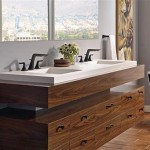Painting a Wood Bathroom Vanity
A fresh coat of paint can dramatically transform a dated or worn bathroom vanity. This relatively simple DIY project can significantly enhance the aesthetic of the bathroom without requiring a complete remodel. Careful preparation and the right materials are crucial for achieving a professional-looking and durable finish that can withstand the humidity and frequent use of a bathroom environment.
The first step in painting a wood bathroom vanity is to assess its current condition. Examine the vanity for any damage, such as cracks, chips, or water damage. These imperfections require repair before painting commences. Filling minor cracks and chips with wood filler and sanding them smooth will ensure a uniform surface for paint adhesion. More extensive damage might require professional repair or replacement of affected parts.
Once any necessary repairs are complete, the vanity needs thorough cleaning. A solution of mild detergent and warm water is effective in removing dirt, grime, and residue from common bathroom products. Rinse the vanity thoroughly with clean water and allow it to dry completely. Residual moisture can interfere with paint adhesion and lead to peeling or bubbling.
The next crucial step is surface preparation. If the existing finish on the vanity is glossy, lightly sanding it with fine-grit sandpaper will create a slightly rough surface for better paint adhesion. This process, known as deglossing, is essential for ensuring the new paint bonds effectively with the existing surface. After sanding, remove all dust with a tack cloth or a damp cloth, ensuring the surface is clean and free of debris.
Protecting surrounding areas from paint splatters is vital before painting begins. Cover the countertop, sink, floor, and any adjacent walls with drop cloths or painter's tape and masking paper. This precautionary step simplifies cleanup and prevents accidental paint transfer to unintended surfaces.
Applying a primer is highly recommended before painting the vanity. Primer creates a uniform base for the paint, enhancing its adhesion and promoting a more even finish. Choose a primer specifically designed for wood and suitable for use in high-humidity environments like bathrooms. Apply a thin, even coat of primer to the entire vanity, allowing it to dry completely according to the manufacturer's instructions.
Selecting the right paint for a bathroom vanity is essential for durability and longevity. Opt for a high-quality, moisture-resistant paint formulated for interior use. Latex or acrylic paints are generally suitable for bathroom vanities due to their durability and water resistance. Semi-gloss or satin finishes are popular choices for bathroom vanities as they are easy to clean and resist mildew growth. Avoid using flat or matte paints, as they are more susceptible to moisture damage and staining.
When painting the vanity, apply thin, even coats to avoid drips and runs. Using a high-quality brush or roller designed for the chosen paint type will ensure a smooth and even application. Allow each coat of paint to dry completely before applying the next. Multiple thin coats generally produce a more durable and professional-looking finish than one thick coat.
Once the final coat of paint is dry, consider applying a protective topcoat for added durability and moisture resistance. A clear polyurethane sealant, available in various sheens, can provide an extra layer of protection against wear and tear, especially in high-use areas. Follow the manufacturer's instructions for application and drying time.
After the paint and any topcoat have dried thoroughly, carefully remove the painter's tape and masking paper. Reinstall the hardware, such as knobs and pulls, once the paint is completely cured, typically after 24-48 hours. This allows ample time for the paint to harden and prevents damage from handling or reinstallation.
Proper ventilation is essential throughout the entire painting process. Open windows and doors to ensure adequate airflow and minimize exposure to paint fumes. If necessary, use a respirator or mask designed for paint fumes. Proper ventilation also helps accelerate the drying time of the primer, paint, and topcoat.
Cleaning brushes and rollers immediately after use will extend their lifespan and prevent paint from drying and hardening. Use the appropriate cleaning solvent recommended by the paint manufacturer. Dispose of unused paint and cleaning materials responsibly according to local regulations.
Regular cleaning and maintenance will help preserve the newly painted finish on the bathroom vanity. Wipe down the vanity regularly with a damp cloth and mild cleaning solution to remove dirt and grime. Avoid using abrasive cleaners or scouring pads, as these can damage the paint finish.

How To Paint Bathroom Cabinets Secrets For A Perfect Finish

I Painted Our Wooden Bathroom Vanity What Learned Diy Tips Before Afters

I Painted Our Wooden Bathroom Vanity What Learned Diy Tips Before Afters

Step By Guide How To Paint A Bathroom Vanity Cabinet Love Grows Wild

How To Paint A Bathroom Vanity Love Remodeled

Painted Wood Look Easy Vanity Update The Weathered Fox

How To Paint A Bathroom Vanity Secrets For Perfect Finish

Painted Wood Look Easy Vanity Update The Weathered Fox

How To Paint A Bathroom Vanity Secrets For Perfect Finish

I Painted Our Wooden Bathroom Vanity What Learned Diy Tips Before Afters
See Also







